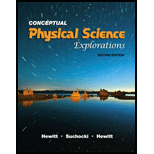
What is a
A chemical bond.
Answer to Problem 10RQ
A chemical bond is a connecting link between two atoms formed by a specific type of attraction.
Explanation of Solution
The atoms having different numbers of valence electrons interact with each other and try to complete its octet. They try to either give their valence electrons or take some other electrons or sometimes even share with others valence electrons to fill their own outermost shell to get their stability.
These chemical interactions occur and elements get bounded together by a connecting link. This connecting link between the elements is called a chemical bond.
Thus, a chemical bond is a connecting link between two atoms formed by a specific type of chemical interaction.
Conclusion:
Therefore, a chemical bond is a connecting link between two atoms formed by a specific type of attraction.
Chapter 17 Solutions
Conceptual Physical Science Explorations
Additional Science Textbook Solutions
Life in the Universe (4th Edition)
Physics for Scientists and Engineers with Modern Physics
University Physics with Modern Physics (14th Edition)
The Cosmic Perspective Fundamentals (2nd Edition)
Essential University Physics: Volume 2 (3rd Edition)
Glencoe Physical Science 2012 Student Edition (Glencoe Science) (McGraw-Hill Education)
 College PhysicsPhysicsISBN:9781305952300Author:Raymond A. Serway, Chris VuillePublisher:Cengage Learning
College PhysicsPhysicsISBN:9781305952300Author:Raymond A. Serway, Chris VuillePublisher:Cengage Learning University Physics (14th Edition)PhysicsISBN:9780133969290Author:Hugh D. Young, Roger A. FreedmanPublisher:PEARSON
University Physics (14th Edition)PhysicsISBN:9780133969290Author:Hugh D. Young, Roger A. FreedmanPublisher:PEARSON Introduction To Quantum MechanicsPhysicsISBN:9781107189638Author:Griffiths, David J., Schroeter, Darrell F.Publisher:Cambridge University Press
Introduction To Quantum MechanicsPhysicsISBN:9781107189638Author:Griffiths, David J., Schroeter, Darrell F.Publisher:Cambridge University Press Physics for Scientists and EngineersPhysicsISBN:9781337553278Author:Raymond A. Serway, John W. JewettPublisher:Cengage Learning
Physics for Scientists and EngineersPhysicsISBN:9781337553278Author:Raymond A. Serway, John W. JewettPublisher:Cengage Learning Lecture- Tutorials for Introductory AstronomyPhysicsISBN:9780321820464Author:Edward E. Prather, Tim P. Slater, Jeff P. Adams, Gina BrissendenPublisher:Addison-Wesley
Lecture- Tutorials for Introductory AstronomyPhysicsISBN:9780321820464Author:Edward E. Prather, Tim P. Slater, Jeff P. Adams, Gina BrissendenPublisher:Addison-Wesley College Physics: A Strategic Approach (4th Editio...PhysicsISBN:9780134609034Author:Randall D. Knight (Professor Emeritus), Brian Jones, Stuart FieldPublisher:PEARSON
College Physics: A Strategic Approach (4th Editio...PhysicsISBN:9780134609034Author:Randall D. Knight (Professor Emeritus), Brian Jones, Stuart FieldPublisher:PEARSON





